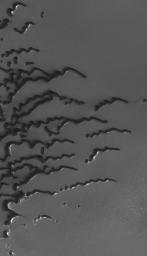
|
Summertime View of North Polar Sand Dunes
- Click the image above for a larger view
- Full-Res JPEG (836 x 1452) (142.5 kB)
- Full-Res TIFF (836 x 1452) (1.2 MB)
Caption:
10 October 2006
This Mars Global Surveyor (MGS) Mars Orbiter Camera (MOC) image shows a suite of dunes in one of the several north polar dune fields. The bright surfaces adjacent to some of the dunes are patches of frost. These dunes spend much of the autumn, winter, and spring seasons covered with carbon dioxide frost. Only in late spring and in summer are the dark windblown sands fully exposed.
Over the course of the 9+ years of the MGS mission, the MOC team has sought evidence that sand dunes may be migrating downwind over time. However, no clear examples of the movement of a whole dune have been identified. On Earth, such movement is typically detectable in air photos of the smallest active dunes over periods of a few years. Owing to the fact that the north polar dunes spend much of each martian year under a cover of frost, perhaps these move much more slowly than their frost-free, terrestrial counterparts. The sand may also be somewhat cemented by ice or minerals, likewise preventing vigorous dune migration in the present environment.
This view covers an area approximately 3 km (1.9 mi) wide and is illuminated by sunlight from the lower left. The dunes are located near 79.8°N, 127.1°W, and the picture was acquired on 11 September 2006.
Cataloging Keywords:
| Name | Value | Additional Values |
|---|---|---|
| Target | Mars | |
| System | ||
| Target Type | Planet | |
| Mission | Mars Global Surveyor (MGS) | |
| Instrument Host | Mars Global Surveyor | |
| Host Type | Orbiter | |
| Instrument | Mars Orbiter Camera (MOC) | |
| Detector | ||
| Extra Keywords | Dune, Grayscale | |
| Acquisition Date | ||
| Release Date | 2006-10-10 | |
| Date in Caption | 2006-09-11 | 2006-10-10 |
| Image Credit | NASA/JPL/Malin Space Science Systems | |
| Source | photojournal.jpl.nasa.gov/catalog/PIA01933 | |
| Identifier | PIA01933 | |
